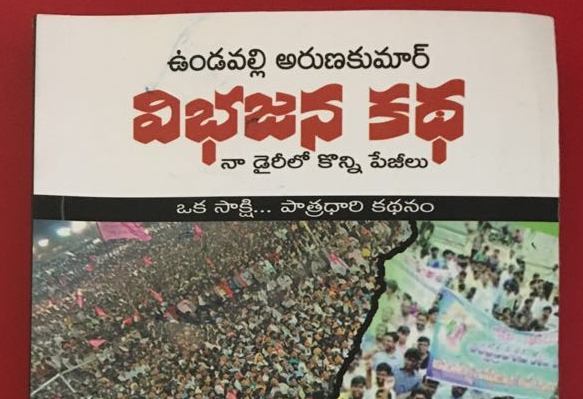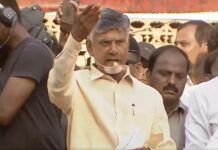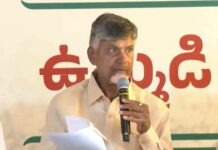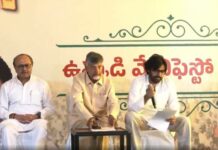
(By Ramesh Kandula)
Few people are aware as to what exactly happened on 18th February 2014 in Lok Sabha when Andhra Pradesh Reorganisation Bill was passed amid unprecedented din and shutdown of live telecast of the proceedings.
Not only were the proceedings on a matter of far reaching consequences not beamed live on television, they in fact were not even videographed, effectively putting a curtain on the issue.
And then, what transpired two days later in Rajya Sabha on the same historic bill remains hazy to this day.
[pullquote position=”left”]Vundavalli’s Vibhajana Katha digs out what he alleges Constitutional violations in the process of bifurcation.[/pullquote]Besides, the issue of whether a state can be divided against its will even after expressing its rejection through a resolution by the Legislature under Article 3 continues to be a grey area, raising questions of Constitutional interpretation.
The disturbing events surrounding the passage of the bill did not attract the attention of journalists, commentators and intellectuals alike because of the sympathy accrued over a period of time for what appeared to be a long-standing demand for a separate state of Telangana.
Since the general perception was in favour of creation of a separate state, nobody seemed unduly perturbed at the apparent Constitutional malfeasance through which it was achieved.
At long last a book written in Telugu throws some light on the rather bizarre and unusual happenings at the fag-end of the UPA II regime. Vibhajana Katha (The Story of Bifurcation) is from the perspective of Vundavalli Arun Kumar, a two-time loyal Congress Member of Parliament and an ardent opponent of the division of the state, who was a witness to the sordid happenings.
Arun Kumar, who was closely involved with the attempts by the Andhra politicians to stall division of the state all through this period, was himself suspended along with several MPs from the region during the crucial proceedings. However, he sifted through the written records of what transpired in Lok Sabha that day. His contention is that the numbers were not favourable in the House on that day to sail the controversial bill through, even though the ruling and the opposition parties – the Congress and the BJP – entered into ‘match-fixing’.
Because of this ‘match-fixing’, the Speaker was influenced to ram the AP Reorganisation Bill through in the most undemocratic manner. Speaker Meira Kumar not only refused to go for division despite demands to this effect by several members from various regional parties, but also did not actually take the head count.
The Lok Sabha records, clearly demonstrate that the Speaker announced results of head count on four amendments, during a period of just 2 minutes. The counting of heads, if it were truly to be done eight times – four times for Ayes and four times for Nos – could not have been completed in such a short time of 120 seconds.
Besides, for one of the amendments, the Speaker’s count was 169-0 against, which meant that even the proponents Sougata Roy (TMC) and Asaduddin Owaisi (MIM) were against their own amendments! After a point, the Speaker did not even maintain the facade of head count, summarily declaring that the amendments were negated.
The Speaker refused to allow division for the bill and its amendments under the proviso Rule 367 (3). Apparently, no Speaker since 1956 disallowed division when pressed by Members on any issue. The Rule 367-(3)(c) says, “”Provided that, if in the opinion of the Speaker, the Division is unnecessarily claimed, he may ask the members who are for `Aye’ and those for `No’ respectively to rise in their places..”
Only three Members, Home Minister Sushil Kumar Shinde, Opposition Leader Sushma Swaraj and another Minister S Jaipal Reddy were allowed to speak in the House. Not one Member opposing the bill was given an opportunity to express their views. It is also not known how many Members finally were in favour of the bifurcation and how many against.
A different kind of drama was witnessed in Rajya Sabha, though live telecast was in place. BJP, which had declared earlier that the party would press for division, if even a single one of their 20 amendments to the bill was not accepted, helped pass the bill even though none of their amendments was conceded by the Government. Several parties, including the CPM insisted on division, but the Deputy Chairman P J Kurien rejected, stating that when the House was not in order, division could not be pressed. But the same rules did not hamper the Lok Sabha – which also witnessed pandemonium all through – to take head count.
Arun Kumar wrote a letter to the President of India highlighting these anomalies and aberrations during the passage of the AP Reorganisation Act, but with no apparent result.
The Supreme Court too chose to adopt an indifferent attitude toward the bifurcation, and its constitutionality. A slew of writs were filed in 2013 by several political parties and persons on various constitutional issues arising out of the bifurcation process. The apex court did not take them up, asking the petitioners to litigate at an appropriate time, as the alleged violations are mere apprehensions of litigants. Later, when Arun Kumar and the then Chief Minister of Andhra Pradesh Kiran Kumar Reddy filed petitions, the court in May 2014 gave 6-weeks time to the Government of India, declaring that the court ‘will set the clock back’ if the Act turned out to be unconstitutional. We are moving towards 2017. The case has not been heard till date.
Arun Kumar sought the opinions of two eminent jurists retired Chief Justices of Supreme Court Justice M N Venkatachalaiah and Justice G B Patnaik on the issues arising out of the proposed bifurcation. The Justices were of the opinion that seeking the views of the Legislature under Article 3 was not a mere formality, and cautioned against the dangerous precedents it can set in future.
What happened in the Speaker’s Chamber between 12 pm and 1 pm in Lok Sabha on that day, according to Arun Kumar, holds the key to what happened later. After the pepper spray incident, the House adjourned. The former MP’s conjecture is that Jaipal Reddy was able to convince Speaker Meira Kumar, Opposition Leader Sushma Swaraj and the ruling party’s pointsman in the House Kamal Nath to bypass the Parliamentary niceties such as restoring order or conducting division, and to hustle the bill through the House by hook or crook, since the two major parties were in favour of it anyway.
While Jaipal Reddy himself said that he would not reveal what happened in the Speaker’s Chamber in those momentous sixty minutes in deference to Parliamentary values, clearly his advice that proviso Rule 367-(3)(c) could be invoked to deny division was effectively made use of by the Speaker in achieving the desired result.
Andhra Pradesh bifurcation and Telangana formation are a reality today, and even if the Supreme Court finds fault with the process of bifurcation, it cannot ‘set the clock back’ at this stage. But it is important that Constitutional issues plaguing the hurried division need to be critically looked at and guidelines issued for such future scenarios, on the lines of the historic S R Bommai case.
Arun Kumar’s commentary with extensive notes hopefully will act as a catalyst for such a relook at the botched up bifurcation process and come up with better alternatives for future.
Vibhajana Katha provides valuable inputs to all those interested in delving deep into reorganisation of states and centre-state relations.

















